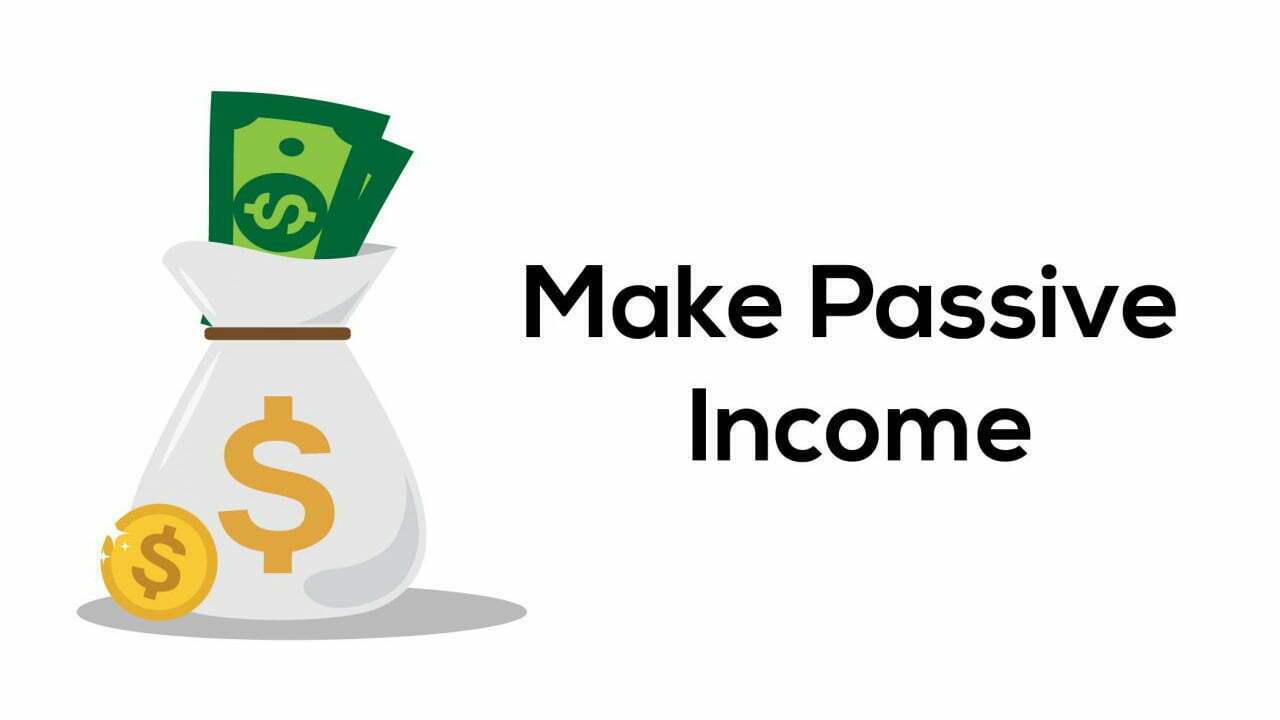
What is passive income?
Passive income includes regular earnings from a source other than an employer or contractor. The Internal Revenue Service (IRS) says passive income can come from two sources: rental property or a business in which one does not actively participate, such as being paid book royalties or stock dividends.
“Many people think that passive income is about getting something for nothing,” says financial coach and retired hedge fund manager Todd Tresidder. “It has a ‘get-rich-quick’ appeal… but in the end, it still involves work. You just give the work upfront.”
In practice, you may do some or all of the work upfront, but passive income often involves some additional labor along the way, too. You may have to keep your product updated or your rental property well-maintained, in order to keep the passive dollars flowing.
But if you’re committed to the strategy, it can be a great way to generate income and you’ll create some extra financial security for yourself along the way.
Passive income is not…
- Your job. Generally, passive income is not income that comes from something you’ve been materially involved in such as the wages you earn from a job.
- A second job. Getting a second job isn’t going to qualify as a passive income stream because you’ll still need to show up and do the work to get paid. Passive income is about creating a consistent stream of income without you having to do a lot of work to get it.
- Non-income-producing assets. Investing can be a great way to generate passive income, but only if the assets you own pay dividends or interest. Non-dividend-paying stocks or assets like cryptocurrencies may be exciting, but they won’t earn you passive income.
11 passive income ideas for building wealth
If you’re thinking about creating a passive income stream, check out these 20 strategies and learn what it takes to be successful with them, while also understanding the risks associated with each idea.
1. Create a course
One popular strategy for passive income is creating an audio or video course, then kicking back while cash rolls in from the sale of your product. Courses can be distributed and sold through sites such as Udemy, SkillShare, and Coursera.
Alternatively, you might consider a “freemium model” – building up a following with free content and then charging for more detailed information or for those who want to know more. For example, language teachers and stock-picking advice may use this model. The free content acts as a demonstration of your expertise and may attract those looking to go to the next level.
Opportunity: A course can deliver an excellent income stream because you make money easily after the initial outlay of time.
Risk: “It takes a massive amount of effort to create the product,” Tresidder says. “And to make good money from it, it has to be great. There’s no room for trash out there.”
Tresidder says you must build a strong platform, market your products and plan for more products if you want to be successful.
“One product is not a business unless you get really lucky,” Tresidder says. “The best way to sell an existing product is to create more excellent products.”
Once you master the business model, you can generate a good income stream, he says.
2. Write an e-book
Writing an e-book can be a good opportunity to take advantage of the low cost of publishing and even leverage the worldwide distribution of Amazon to get your book seen by potentially millions of would-be buyers. E-books can be relatively short, perhaps 30-50 pages, and can be relatively cheap to create, since they rely on your own expertise.
You’ll need to be an expert on a specific topic, but the topic could be niche and use some special skills or abilities that very few offer but that many readers need. You can quickly design the book on an online platform and then even test-market different titles and price points.
But just like with designing a course, a lot of the value comes when you add more e-books to the mix, drawing in more customers to your content.
Opportunity: An e-book can function not only to deliver good information and value to readers but also as a way to drive traffic to your other offerings, including audio or video courses, other e-books, a website, or potentially higher-value seminars.
Risk: Your e-book has to be very strong to build up a following and then it helps if you have some way to market it, too, such as an existing website, promotion on other relevant websites, appearances in the media or podcasts, or something else. So you could put in a lot of work upfront and get very little back for your efforts, especially at first.
And while an e-book is nice, it will help if you write more and then even build a business around the book or make the book just one part of your business that strengthens the other parts. So your biggest risk is probably that you waste your time with little reward.
3. Affiliate marketing
With affiliate marketing, website owners, social media “influencers” or bloggers promote a third party’s product by including a link to the product on their site or social media account. Amazon might be the best-known affiliate partner, but eBay, Awin, and ShareASale are among the larger names, too. And Instagram and TikTok have become huge platforms for those looking to grow a following and promote products.
You could also consider growing an email list to draw attention to your blog or otherwise direct people to products and services that they might want.
Opportunity: When a visitor clicks on the link and makes a purchase from the third-party affiliate, the site owner earns a commission. The commission might range from 3 to 7 percent, so it will likely take significant traffic to your site to generate serious income. But if you can grow your following or have a more lucrative niche (such as software, financial services or fitness), you may be able to make some serious coin.
Affiliate marketing is considered passive because, in theory, you can earn money just by adding a link to your site or social media account. In reality, you won’t earn anything if you can’t attract readers to your site to click on the link and buy something.
Risk: If you’re just starting out, you’ll have to take time to create content and build traffic. It can take significant time to build a following, and you’ll have to find the right formula for attracting that audience, a process that itself might take a while. Worse, once you’ve spent all that energy, your audience may be apt to flee to the next popular influencer, trend, or social media platform.
4. Flip retail products
Take advantage of online sales platforms such as eBay or Amazon, and sell products that you find at cut-rate prices elsewhere. You’ll arbitrage the difference in your purchase and sale prices, and may be able to build a following of individuals who track your deals.
Opportunity: You’ll be able to take advantage of price differences between what you can find and what the average consumer may be able to find. This could work especially well if you have a contact who can help you access discounted merchandise that few other people can find. Or you may be able to find valuable merchandise that others have simply overlooked.
Risk: While sales can happen at any time online, helping make this strategy passive, you’ll definitely have to hustle to find a reliable source of products. Plus, you’ll have to invest money in all of your products until they do sell, so you need a robust source of cash. You’ll have to really know the market so that you’re not buying at a price that’s too high. Otherwise, you may end up with products that no one wants or whose price you have to drastically cut in order to sell.
5. Sell photography online
Selling photography online might not be the most obvious place to set up a passive business, but it could allow you to scale your efforts, especially if you can sell the same photos over and over again. To do that, you might work with an organization such as Getty Images, Shutterstock or Alamy.
To get started, you’ll have to be approved by the platform, and then you license your photos to be used by whoever downloads them. The platform then pays you every time someone uses your photo.
You’ll need photos that appeal to a specific audience or that represent a certain scene, and you’ll need to tease out where the demand is. Photos could be shots with models, landscapes, creative scenarios, and more, or they could capture real events that might make the news.
Opportunity: Part of the value of selling or licensing your photos through a platform is that you have the potential to scale your efforts, especially if you can provide pictures that will be in demand. That means you could potentially sell the same image hundreds or thousands of times or more.
Risk: You could add hundreds of photos to a platform such as Getty Images and not have any of them really generate meaningful sales. Only a few photos may drive all of your revenue, so you have to keep adding photos as you search for that needle in the haystack.
It may require substantial effort to go out and shoot photos, then process them and keep up with the events that may ultimately drive your revenue. And motivation could be hard to maintain: Every next photo might be your lottery ticket, though it almost certainly won’t be.
6. Create an app
Creating an app could be a way to make that upfront investment of time and then reap the reward over the long haul. Your app might be a game or one that helps mobile users perform some hard-to-do functions. Once your app is public, users download it, and you can generate income.
Opportunity: An app has a huge upside if you can design something that catches the fancy of your audience. You’ll have to consider how best to generate sales from your app. For example, you might run in-app ads or otherwise have users pay a nominal fee for downloading the app.
If your app gains popularity or you receive feedback, you’ll likely need to add incremental features to keep the app relevant and popular.
Risk: The biggest risk here is probably that you use your time unprofitably. If you commit little or no money to the project (or money that you would have spent anyway, for example, on hardware), you have little financial downside here. However, it’s a crowded market and truly successful apps must offer a compelling value or experience to users.
You’ll also want to make sure that if your app collects any data that it’s in compliance with privacy laws, which differ across the globe. The popularity of apps can be short-lived, too, meaning your cash flow could dry up a lot faster than you expect.
7. Sponsored posts on social media
Do you have a strong following on social media such as Instagram or TikTok? Get growing consumer brands to pay you to post about their product or otherwise feature it in your feed.
You’ll need to keep filling your profile with content that draws in your audience, though. And that means continuing to create posts that grow your reach and engage your followers on social media.
Opportunity: Leveraging your social media presence is an attractive business model. Draw eyeballs and clicks to your profile with strong content and then monetize that content by setting up sponsored posts from brands that appeal to your followers.
Risk: Getting started here can be a Catch-22: You need a large audience to get meaningful sponsored posts, but you’re not an attractive option until you get a meaningful audience. So you’ll have to focus a lot of time first on growing your audience with no guarantee that you’ll be successful. You can end up spending tons of time following the trends and building content, in the hopes that you eventually get the sponsorship that you’re aiming for.
Even when you’ve got the sponsored posts you’re looking for, you’ll need to keep posting to draw in your audience and remain an attractive option for advertisers. That means committing to more time and monetary investment, even if you do have a lot of autonomy on exactly when to do it.
8. Rent out your home short-term
This straightforward strategy takes advantage of space that you’re not using anyway and turns it into a money-making opportunity. If you’re going away for the summer or have to be out of town for a while, or maybe even just want to travel, consider renting out your current space while you’re gone.
Opportunity: You can list your space on any number of websites, such as Airbnb, and set the rental terms yourself. You’ll collect a check for your efforts with minimal extra work, especially if you’re renting to a tenant who may be in place for a few months.
Risk: You don’t have a lot of financial downsides here, though letting strangers stay in your house is a risk that’s atypical of most passive investments. Tenants may deface or even destroy your property or even steal valuables, for example.
9. Advertise on your car
You may be able to earn some extra money by simply driving your car around town. Contact a specialized advertising agency, which will evaluate your driving habits, including where you drive and how many miles. If you’re a match with one of their advertisers, the agency will “wrap” your car with the ads at no cost to you. Agencies are looking for newer cars, and drivers should have a clean driving record.
Opportunity: While you do have to get out and drive if you’re already putting in the mileage anyway, then this is a great way to earn hundreds per month with little or no extra cost. Drivers can be paid by the mile.
Risk: If this idea looks interesting, be extra careful to find a legitimate operation to partner with. Many fraudsters set up scams in this space to try and bilk you out of thousands.
10. Create a blog or YouTube channel
Are you an expert on travel to Thailand? A maven of Minecraft? A sultan of swing dancing? Take your passion for a subject and turn it into a blog or a YouTube channel, using ads or sponsors to generate your income. Find a popular subject, even a small niche, and become an expert on it. At first, you’ll have to build out a suite of content and draw an audience, but it can create a steady income stream over time, as you become known for your engaging content.
Opportunity: You can leverage a free (or very low-cost) platform, then use your great content to build a following. The more unique your voice or area of interest, the better for you to become “the” person to follow. Then draw sponsors to you.
Risk: You’ll have to build out content at the start and then create ongoing content, which can take time. And you’ll need to be really passionate about the product, since that can help you maintain the motivation to continue, especially at the start as your followers are still finding you.
The real downside here is that you can outlay a bunch of your time and resources, with little to show for it, if there’s limited interest in your subject or niche. Your area of expertise may be too niche to really draw a profitable audience, but you won’t be sure of that until you experiment.
11. Sell designs online
If you have design skills, you may be able to turn them into a money maker by selling items with your printed designs on them. Businesses such as CafePress and Zazzle allow you to sell items such as T-shirts, hats, mugs, and more with your own designs.
Opportunity: You can start with your own designs and see what the market is interested in, and expand from there. You may be able to capitalize on the surging interest in a current event and design a shirt that captures the spirit of the times or at least a snarky take on it. And you can also set up your own web storefront through a site such as Shopify to market your goodies.
Risk: Printing partners allow you to ship items without directly investing in the merchandise yourself, avoiding one of the biggest risks of tying up your capital. But you may be able to get better pricing if you invest in some of the inventory yourself. Another big risk here is that you could invest a lot of time with little payoff, but this avenue might be interesting if you’re already doing the design work for another purpose, such as personal interest.
Which passive income source is best?
The question of which passive income source is best depends on several factors, but some of the most important include the amount of money you have to invest, the total opportunity size, your interest and ability in the area, the amount of time you need to invest and the potential to succeed. Typically, the lower the barriers to entry, the more crowded the field of competitors and the lower likelihood of success.
So you’ll need to weigh the opportunity against these factors and see which passive income strategy works best for you. But it can be helpful to have natural ability and an interest in your target area because these can help motivate you in the early days when things are likely to be tougher.
There are passive income opportunities for people who are starting out with some money and even those who have no money to start.
How can I make passive income with no money?
If you have little or no money to start, you’ll have to rely mostly on your own time investment to power you through, at least until you build up a little money. That means focusing on passive income sources that take advantage of the following traits:
- An area where you’re an expert. Here you can build your expertise out into a useful product or service for consumers, e.g. design, software coding, and others.
- An upfront work-heavy opportunity. You’ll need an opportunity that requires a time or work investment, such as creating a course, building out an influencer profile, or other options.
In effect, you’re substituting your time for your lack of capital, until you can get enough capital to expand your set of opportunities.




